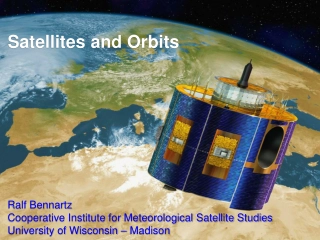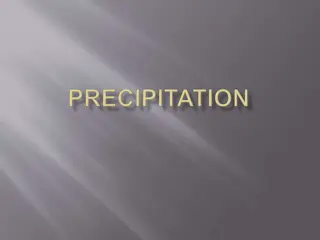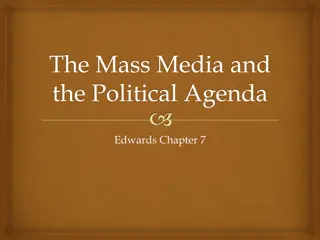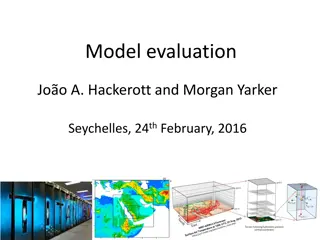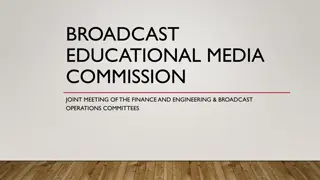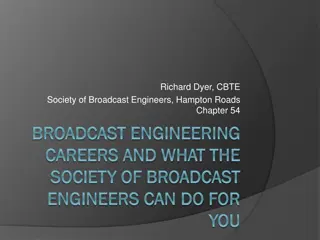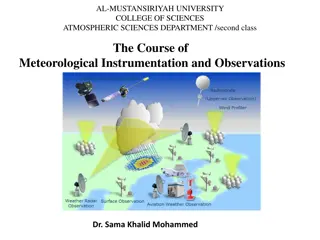Satellites and Orbits
The realm of satellites and orbits, covering topics such as Kepler's Laws, meteorological satellite orbits, the history of satellite remote sensing, and different types of orbits including geostationary and sun-synchronous orbits. Explore the significance of inclination angles, orbital speeds, and d
3 views • 22 slides
Advancements in Solar-Terrestrial Research and Meteorology
The Solar-Terrestrial Centre of Excellence (STCE) focuses on ongoing activities and opportunities in the field of meteorology, with a special emphasis on Antarctica. Their annual meetings cover topics like water vapor feedback mechanisms, extreme weather events forecasting, cloud and precipitation s
0 views • 14 slides
Environmental Workshop Overview: Ministry of Environment in the Solomon Islands
The Environment and Conservation Division (ECD) of the Ministry of Environment, Climate Change, Disaster Management, and Meteorology in the Solomon Islands focuses on sustainable environmental management, conservation, and protection of natural resources. The ECD's vision is to safeguard the environ
1 views • 15 slides
Understanding Irrigation Scheduling for Optimal Crop Yield
Scientific irrigation scheduling plays a vital role in determining the correct timing and quantity of water application for crops to enhance yields efficiently while preserving soil quality. Various criteria are utilized in irrigation scheduling, such as potential evapotranspiration (PET) estimation
13 views • 58 slides
Understanding Precipitation in Meteorology
Precipitation in meteorology is the result of atmospheric water vapor condensing and falling to Earth, a vital element of hydrology. It can occur in liquid or solid forms through processes like evaporation, cooling, condensation, and droplet growth. Different geographic and climate conditions impact
0 views • 17 slides
Understanding Basic Meteorology Concepts for Air Quality Management
Pollutants circulate in the troposphere following air movement patterns around low-pressure fronts and high-pressure systems. Anticyclones and cyclones play a crucial role in atmospheric stability and pollutant dispersion. The relationship between lapse rates determines air stability and pollutant d
0 views • 24 slides
Restructuring of USACE HEC-HMS Meteorologic Model
Significant modifications have been made to the HEC-HMS meteorologic model to enhance modeling tasks' ease and intuitiveness. The Met Model Restructure updates in versions 4.9 to 4.11 streamline meteorologic processes, introduce new features like automatic linkages and zonal editors for snowmelt, an
0 views • 19 slides
Evolution of Media Influence on Politics
The evolution of mass media and its impact on politics is explored, highlighting the important role of media events, high-tech politics, and the development of media politics through print and broadcast media. The government regulation of the broadcast media, as overseen by the FCC, is also discusse
4 views • 20 slides
Understanding Outside Broadcast Operations
Outside broadcasting (OB) involves the electronic field production of television or radio programs from a mobile remote broadcast studio. This presentation aims to help participants grasp OB operations and set up the OB van for operation. It covers the introduction to OB, equipment setup, challenges
0 views • 13 slides
Understanding Synoptic Meteorology: A Comprehensive Overview
Synoptic meteorology delves into various aspects of atmospheric sciences, encompassing scales of atmospheric motion, weather maps, air masses, fronts, jet streams, and more. Through the study of synoptic meteorology, meteorologists gain insights into interpreting the state of the troposphere and for
1 views • 17 slides
Enhancing 802.11 Scheduling with Broadcast TWT and TIM Mechanisms
The January 2017 document IEEE 802.11-17/0117r0 discusses the implementation of coordinated multi-user downlink and triggered multi-user uplink in 802.11 systems to improve scheduling and reduce collisions. It proposes aligning power saving wake times using Target Wake Time (TWT) for better efficien
1 views • 17 slides
Round-Efficient Byzantine Broadcast Under Strongly Adaptive and Majority Corruptions
This paper discusses a round-efficient Byzantine broadcast protocol that addresses strong adaptive adversaries and majority corruptions. The protocol involves unique and unbreakable peer signatures, committees for message verification, and time-locking mechanisms to prevent message tampering. By uti
1 views • 5 slides
Alumni of the Month Ryan Lueck - Graduate Student Spotlight
Ryan Lueck, Alumni of the Month, shares his journey from undergraduate studies in meteorology to graduate school focusing on upward lightning phenomena. He provides insights into his experience in graduate school, his research on lightning, and offers valuable advice for those interested in pursuing
1 views • 5 slides
Understanding Mobile Computing Services and Broadcast Receivers
Mobile computing services play a vital role in background operations of apps, allowing them to perform tasks even when not in use. Broadcast receivers help in efficient communication between components. Learn about key concepts and examples of services, how they are declared in the app manifest, and
2 views • 72 slides
Exploring the Fundamentals of Synoptic Meteorology at Mustansiriya University
Dive into the course of Synoptic Meteorology offered at Mustansiriya University with topics covering atmospheric motion scales, weather maps, air masses, fronts, and jet streams. Learn how to analyze and interpret weather data through the study of high and low-pressure systems, jet streams, and more
0 views • 17 slides
Understanding Model Evaluation in Meteorology
Model evaluation in meteorology involves verifying, hypothesizing, proving, and improving models through a systematic process. Factors such as error analysis, grid spacing, model resolution, domain size, computational errors, chaotic equations, and initial condition errors play critical roles in ass
0 views • 17 slides
Understanding Air Masses in Meteorology
Air masses play a significant role in meteorology, covering vast areas with uniform physical properties. They are classified based on temperature, moisture content, and source regions, which can be continental or maritime. Air masses form in regions with little wind and can sit over an area for an e
0 views • 27 slides
Potential Intelligent Transportation System Use Cases for Broadcast Services Study Group
This presentation highlights potential Intelligent Transportation System use cases for consideration by the Broadcast Services Study Group. The use cases were derived from the Architecture Reference for Cooperative and Intelligent Transportation (ARC-IT). While not exhaustive, the presentation provi
1 views • 19 slides
Exact Byzantine Consensus on Undirected Graphs: Local Broadcast Model
This research focuses on achieving exact Byzantine consensus on undirected graphs under the local broadcast model, where communication is synchronous with known underlying graphs. The model reduces the power of Byzantine nodes and imposes connectivity requirements. The algorithm involves flooding va
0 views • 7 slides
Insights into Meteorology and Warning Systems at Iowa State University
Discover the journey of Daryl Herzmann, a meteorology expert from Iowa State University, as he shares his experiences working with NWS and creating tools like NWSChat. Explore the concept of "Dog and Pony Show," his achievements, and the purpose of his maps in understanding weather gradients.
0 views • 66 slides
Financial Statement Overview: Broadcast Educational Media Commission Meeting
Financial statements and budget details from the joint meeting of the Finance and Engineering & Broadcast Operations Committees of the Broadcast Educational Media Commission on March 1, 2024, including operating budget breakdowns, encumbrances, subsidy funds, and allocation details.
0 views • 5 slides
Understand Broadcast Receivers in Android Development
Discover the role of broadcast receivers in Android development as components that allow registration for system or application events. Learn how to register receivers, receive intents, and utilize popular system broadcasts for efficient app functionality. Explore static and dynamic registration met
0 views • 20 slides
BBC Event Producers: Broadcast Use Cases & Solutions
This document from September 2018 explores various broadcast use cases from event producers at the BBC. It discusses the challenges faced during public events like festivals and premieres and suggests solutions leveraging Wi-Fi technology to enhance audience experiences, staff operations, and overal
0 views • 10 slides
Understanding Concurrent Broadcast for Information Dissemination
Concurrent broadcast facilitates the efficient dissemination of information across network nodes through message contention and transmission. This method finds applications in adaptive routing and communication networks, aiding in the collection and distribution of global network status information
0 views • 21 slides
Efficient Multisource Broadcast in Wireless Networks
This paper delves into the challenges of propagating information efficiently in wireless networks with varying message sources. It introduces concepts like unit disk graphs, competitive ratio, and minimum-latency multi-source broadcast to address the problem. The solution involves a multi-phase appr
0 views • 39 slides
Efficient Handling of WiFi Broadcast Traffic in Smartphone Suspend Mode
Exploring the dilemma of managing WiFi broadcast traffic in smartphone suspend mode through methods like "receive-all" and "receive-none", this study discusses the power impact and efficiency of different approaches. It evaluates the balance between power consumption and functionality, highlighting
0 views • 18 slides
Understanding Computer Networking: Broadcast and Multicast Protocols
In this lecture on computer networking, we explore the concepts of broadcast and multicast protocols. The discussion covers topics such as BGP routing, IPv4 anycast hack, IP multicast, and the role of broadcast in small-to-moderate sized ad hoc networks. Learn about the differences between unicast,
0 views • 20 slides
Implementation and Validation of Multimedia Broadcast Multicast Service for LTE/LTE-Advanced
This study discusses the implementation and validation of a multimedia broadcast multicast service for LTE/LTE-Advanced using the OpenAirInterface platform. It explores the motivation behind enhancing multimedia capabilities in high-capacity mobile networks and the challenges related to previous res
0 views • 28 slides
Explore Careers in Broadcast Engineering with the Society of Broadcast Engineers
The Society of Broadcast Engineers (SBE) is a non-profit organization dedicated to professional development in broadcast engineering. Discover employment sectors, technical disciplines, specialists, salary predictors, and the services SBE offers for broadcast engineers at all levels. Join SBE to acc
0 views • 15 slides
Understanding Broadcast Television and Radio: A Comprehensive Course Overview
This course delves into the history, contemporary forms, and impact of broadcast television and radio, exploring academic approaches, traditions, and critical orientations in the field. Students will analyze ownership structures, audience dynamics, regulatory frameworks, and content production in na
0 views • 7 slides
Understanding Frontogenesis and Frontolysis in Meteorology
Meteorology enthusiasts can explore the concepts of frontogenesis and frontolysis, the evolution of cyclones, and the role of the Norwegian School Meteorologists in describing fronts. Dive into the mechanisms behind the formation and weakening of horizontal temperature gradients, the interaction bet
0 views • 60 slides
Understanding Atmospheric Stability and Lapse Rates in Meteorology
Explore the concepts of lapse rates, stability determination, adiabatic processes, and cloud formation in meteorology. Learn how to calculate lapse rates, assess atmospheric stability, and predict cloud formation conditions based on temperature changes with altitude. Dive into real-world examples an
0 views • 13 slides
Understanding Pressure Surfaces and Environmental Lapse Rates in Meteorology
This content discusses how pressure surfaces slope from low to high latitudes due to temperature changes, calculating the slope of pressure surfaces at different latitudes, determining wind speed based on slope, computing environmental lapse rates, and analyzing stability using dry and moist adiabat
0 views • 12 slides
FIA WEC 2024 TV Distribution Details for 14th July 2024
A comprehensive overview of the TV distribution schedule for the FIA WEC 2024 event on the 14th of July, 2024. The broadcast partners across various regions such as Pan-Europe, Pan-Asia-Pacific, France, MENA, Africa, Americas, and more are detailed. Eurovision Sports News will cover the event in Pan
0 views • 22 slides
Understanding Digital Video: Fundamentals and Standards
Explore the fundamentals of digital video, including frame rates, broadcast standards, CRT monitors, and interlacing artifacts. Learn about the importance of frame rate, how CRT monitors display pictures, and the different broadcast standards like NTSC, PAL, and SECAM. Discover the nuances of tracin
0 views • 38 slides
Radiosonde Technology and Upper Atmosphere Measurements in Meteorology
Upper atmosphere measurements above the surface are crucial for forecasting and research in meteorology. Radiosondes, carried by balloons, provide data on pressure, temperature, humidity, wind speed, and direction. These measurements are vital for analyses and research, especially in emergency situa
0 views • 19 slides
IEEE 802.11-19/0219r3 TGbc Enhanced Broadcast Services Agenda
The March 2019 document outlines the agenda for the IEEE 802.11-19/0219r3 TGbc Enhanced Broadcast Services meeting, including details of the chairs, vice chairs, location, and opening formalities. Instructions for meeting protocol and registration are also provided.
0 views • 20 slides
Understanding Virtual Temperature in Meteorology
Virtual temperature (TV) is a crucial concept in meteorology, representing the temperature a dry air parcel would have under specific conditions. It allows for adjustments in convective potential energy assessments and is essential for interpreting Skew-T log-P diagrams. When calculated accurately,
0 views • 4 slides
Enhancing Broadcast Operations in IEEE 802.11 Networks
This document discusses the benefits of incorporating broadcast operations alongside groupcast in IEEE 802.11 networks, emphasizing the importance of assured message delivery for scenarios like Left Turn Assistance and Crossing Pedestrian alerts. It also proposes eliminating setup and teardown proce
0 views • 12 slides
Success Journey of Chris Conoan: From ISU AMS to ABC5 Meteorologist
Chris Conoan, the Alumni of the Month, shares insights on his career as a meteorologist at ABC5 in West Des Moines. He highlights the role of ISU AMS in shaping his path, the challenges he faced, and offers advice to current students aspiring to enter the field of broadcast meteorology. His experien
0 views • 5 slides
